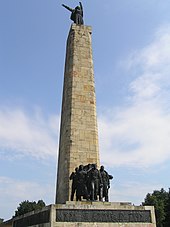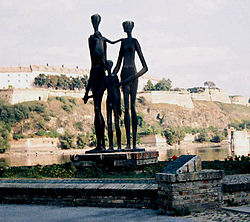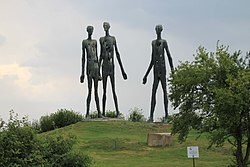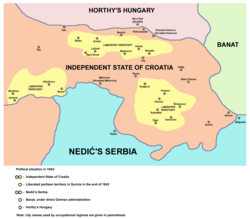| Revision as of 21:35, 31 March 2007 editSuriel1981 (talk | contribs)Extended confirmed users, Rollbackers15,330 editsm Reverted 1 edit by 195.56.14.113 identified as vandalism to last revision by PANONIAN. (TW)← Previous edit | Latest revision as of 18:47, 21 July 2024 edit undoShadow4ya (talk | contribs)Extended confirmed users6,772 edits RV Undid revision 1235869654 by Dalmatinska (talk)Tag: Undo | ||
| (176 intermediate revisions by 84 users not shown) | |||
| Line 1: | Line 1: | ||
| {{Multiple issues| | |||
| ⚫ | ] dedicated to killed |
||
| {{Notability|Events|date=August 2012}} | |||
| ⚫ | ] | ||
| {{Primary sources|date=February 2009}} | |||
| ]]] | |||
| }} | |||
| ⚫ | |||
| ] | |||
| ==Overview== | |||
| ], dedicated to the ] in Vojvodina]] | |||
| The ] of the ] region of ] (now in ]) from 1941 to 1944 was carried out by ] and its client states / puppet regimes: ] ] and ]. | |||
| ⚫ | During the four years of occupation, the Axis forces committed numerous war crimes against civilian population: about 50,000 people in Vojvodina were murdered and about 280,000 were arrested, violated or tortured. |
||
| ⚫ | In 1941, during ], Nazi Germany, ] and Hungary invaded and ]. The modern-day Vojvodina region (then the northern part of ] province of Yugoslavia) was divided into three occupation zones: ] was part of the area governed by the ] and was de facto under control of its ethnic German minority; ] was attached to ] ]; while ] was attached to ]. The occupation lasted until 1944, when the region came under control of the Soviet Red Army and Yugoslav partisans. | ||
| ⚫ | |||
| ==War crimes== | |||
| ] | |||
| ⚫ | ] in ] dedicated to killed Serbian and Jewish civilians in the 1942 raid.]] | ||
| ⚫ | ] | ||
| ], monument to the victims of the ], near ].]] | |||
| ⚫ | During the four years of occupation, the Axis forces committed numerous war crimes against civilian population: about 50,000 people in Vojvodina were murdered and about 280,000 were arrested, violated or tortured.<ref>''Enciklopedija Novog Sada'', Sveska 5, Novi Sad, 1996 (page 196).</ref> The victims belonged to several ethnic groups that lived in Vojvodina, but the largest number of the victims were ], ] and ] people.<ref>Dimitrije Boarov, Politička istorija Vojvodine, Novi Sad, 2001, page 183.</ref> | ||
| ===Total number of victims=== | |||
| According to historian Dragoljub Živković, approximately 55,000 civilians died in Vojvodina during the Axis occupation.<ref name = "Zivkovic">{{Dead link|date=May 2023 |bot=InternetArchiveBot |fix-attempted=yes }}, ]</ref> Of those, approximately 17,000 were ]. | |||
| ⚫ | According to demographer Slobodan Ćurčić, the total number of the people killed by the occupiers between 1941 and 1944 in the entire Vojvodina was 55,285, including:<ref name="Ćurčić">Slobodan Ćurčić, ''Broj stanovnika Vojvodine'', Novi Sad, 1996 (pages 42, 43).</ref> | ||
| *18,193 people who were killed directly | *18,193 people who were killed directly | ||
| *19,004 people who were sent to concentration camps and killed there | *19,004 people who were sent to concentration camps and killed there | ||
| Line 15: | Line 28: | ||
| *10,634 killed members of the resistance movement | *10,634 killed members of the resistance movement | ||
| ==Victims in Bačka== | ===Victims in Bačka=== | ||
| The total number of the killed people in Bačka was 19,573, including:<ref name="Ćurčić" /> | The total number of the killed people in Bačka was 19,573, including:<ref name="Ćurčić" /> | ||
| *6,177 people who were killed directly | *6,177 people who were killed directly | ||
| Line 24: | Line 36: | ||
| *1,674 killed members of the resistance movement | *1,674 killed members of the resistance movement | ||
| Of the total number of the victims (excluding the killed members of the resistance movement), 11,521 were men, 3,768 were women, 1,283 were |
Of the total number of the victims (excluding the killed members of the resistance movement), 11,521 were men, 3,768 were women, 1,283 were elderly people, and 1,327 were children. | ||
| == |
====1942 raid==== | ||
| {{Main|1942 raid in southern Bačka}} | |||
| ⚫ | The most notable war crime during the occupation was the mass murder of the civilians, mostly of ] and ] ethnicity, performed by the Hungarian Axis troops in January 1942 raid in southern Bačka. Total number of civilians killed in the raid was 3,808, while places that were affected by the raid include ], ], ], ], ], ], ], ], ], ], ], ], ] and ].<ref>Zvonimir Golubović, ''Racija u Južnoj Bačkoj 1942. godine'', Novi Sad, 1991 (pages 146, 147).</ref> | ||
| ====1944 deportations of Jews==== | |||
| In March 1944 German units that occupied Horthy's Hungary entered Bačka and Gestapo men were with them. Without any delay the most cruel measures were introduced: the plunder of Jewish property was completed to be absolutely total; Jews had to wear the yellow mark; they were all confined to transit camps before very long to be taken, sometime in June 1944 first to Hungary and then to concentration camps in Austria and Germany. Most of them ended their journey in Auschwitz. Very few of them succeeded to survive and to return. Genocide in Bačka claimed a total of 14,000 Jewish victims. According to available data out of the Jewish victims of genocide 3,800 were from Banat, 11,000 from Serbia and about 260 from Sandžak. Out of about 82,000 members of the Jewish community in Yugoslavia only 15,000 survived World War II which means that 79,2% perished.<ref>JEWS OF YUGOSLAVIA 1941 - 1945 VICTIMS OF GENOCIDE AND FREEDOM FIGHTERS By Jasa Romano (From the English summary in the book Jevreji Jugoslavije 1941-1945. Zrtve Genocida I Ucesnici Narodnosloodilckog Rata, Belgrade: Federation of Jewish Communities of Yugoslavia, 1980; pp. 573-590.)</ref> | |||
| ⚫ | ===Victims in Banat=== | ||
| The total number of the killed people in Banat was 7,513, including:<ref name="Ćurčić" /> | The total number of the killed people in Banat was 7,513, including:<ref name="Ćurčić" /> | ||
| *2,211 people who were killed directly | *2,211 people who were killed directly | ||
| Line 35: | Line 53: | ||
| *2,358 killed members of the resistance movement | *2,358 killed members of the resistance movement | ||
| Of the total number of the victims (excluding the killed members of the resistance movement), 4,010 were men, 631 were women, 243 were old people, and 271 were children. |
Of the total number of the victims (excluding the killed members of the resistance movement), 4,010 were men, 631 were women, 243 were old people, and 271 were children. | ||
| ⚫ | ==Victims in |
||
| ===Victims in Syrmia=== | |||
| The total number of the killed people in Syrmia was 28,199, including:<ref name="Ćurčić" /> | The total number of the killed people in Syrmia was 28,199, including:<ref name="Ćurčić" /> | ||
| *9,805 people who were killed directly | *9,805 people who were killed directly | ||
| Line 46: | Line 63: | ||
| *6,602 killed members of the resistance movement | *6,602 killed members of the resistance movement | ||
| Of the total number of the victims (excluding the killed members of the resistance movement), 14,484 were men, 3,662 were women, 1,279 were old people, and 2,172 were children. |
Of the total number of the victims (excluding the killed members of the resistance movement), 14,484 were men, 3,662 were women, 1,279 were old people, and 2,172 were children. | ||
| == |
==Liberation struggle== | ||
| ] | |||
| ] | |||
| ⚫ | The most notable war crime was the mass murder of the civilians, mostly of ] and ] ethnicity, performed by the Hungarian Axis troops in 1942 raid in southern Bačka. Total number of civilians killed in the raid was 3,808, while places that were affected by the raid include ], ], ], ], ], ], ], ], ], ], ], ], ] |
||
| The resistance movement against Axis occupation was started in summer of 1941 by the ]. The resistance in ] and ] was soon defeated, while resistance in ] had more success. The Syrmian resistance movement grew into a popular uprising, and a large liberated territory (that included about 40 villages) was established in Syrmia. On liberated territory, a ] authority was organized, which included mass ] organizations, publishing activity, and education. The experiences of the resistance movement in Syrmia were transferred to Banat and Bačka in the summer of 1944; before the ] ] arrived in October 1944, Vojvodina already had its new institutions of people's administration. The liberation movement was organized into 18 Vojvodinian brigades divided into 3 squadrons. 15,000 fighters of the resistance movement were killed during the liberation struggle. | |||
| The victims included 2,578 ethnic Serbs, 1,068 Jews, 64 Roma, 31 Rusyns, 21 Hungarians, and 15 Russians. | |||
| Some Hungarian sources claimed that raid was organized by some disloyal Hungarian officers (lieutenant-general ], major-general ], colonel ] and gendarmarie-captain ]), <ref name="Ilona">]: ''Becsület és kötelesség'', part I p.236 (Európa press, Budapest, 2001.) ISBN 963-07-6544-6</ref> <ref name="Horthy"> p. 235-236 ISBN 0966573439 (PDF)</ref> but it was proved that raid was well planed and organized by the highest military and political leaders of Hungary, including ] (the chief of Hungarian army), ] (the minister of defence), ] (the minister of police), Dr. ] (president of Hungarian government), and regent ] himself. <ref>Zvonimir Golubović, Racija u Južnoj Bačkoj, 1942. godine, Novi Sad, 1991. (page 194)</ref> | |||
| In 1943, the Hungarian leaders attempted to revive relations with western Allies, thus as part of such aims, Hungary organized a trial to several officers that were among those responsible for the raid. <ref name="Ilona" /> <ref name="Horthy" /> However, the officers were allowed to escape to Germany before their sentences were uttered, and no matter that court proved their guilt, their sentences were not uttered since they were not in the country. <ref>Zvonimir Golubović, Racija u Južnoj Bačkoj, 1942. godine, Novi Sad, 1991. (page 187)</ref> After the war, some of the individuals responsible for the raid were tried again by the new communist government of Hungary (which sentenced them to death or to life in prison) and again in Yugoslavia, where they were sentenced to death again, and executed. László Deák and Miklos Horthy, who were also among those responsible for the raid, were never convicted. | |||
| ==Notes== | |||
| ⚫ | <references/> | ||
| ==See also== | ==See also== | ||
| ⚫ | *] | ||
| *] | *] | ||
| *] | *] | ||
| *] | *] | ||
| *] | *] | ||
| *] | *] | ||
| == |
==Footnotes== | ||
| ⚫ | <references/> | ||
| * | |||
| ⚫ | * | ||
| ⚫ | * | ||
| ⚫ | * (in Serbian) | ||
| ==References== | |||
| ⚫ | ] | ||
| *Zvonimir Golubović, ''Racija u Južnoj Bačkoj'', 1942. godine, Novi Sad, 1991. | |||
| ⚫ | ] | ||
| *Slobodan Ćurčić, ''Broj stanovnika Vojvodine'', Novi Sad, 1996. | |||
| ⚫ | ] | ||
| *''Enciklopedija Novog Sada'', Sveska 5, Novi Sad, 1996. | |||
| ⚫ | ] | ||
| *Dimitrije Boarov, ''Politička istorija Vojvodine'', Novi Sad, 2001. | |||
| ⚫ | ] | ||
| *''Autonomija Vojvodine - izabrani spisi, Politička teorija i praksa - knjiga 4'', Centar PK SKV za političke studije i marksističko obrazovanje, Novi Sad, 1976. | |||
| ⚫ | ] | ||
| *''Ustanak 1941. - 60 godina posle, govori i članci'', Novi Sad, 2002. | |||
| *''Vojvodina u borbi - zbirka članaka iz narodnooslobodilačke borbe'', Novi Sad, 1951. | |||
| * ], Miha Tavcar: ''Hungary, the Great Powers, and the Danubian Crisis, 1936-1939'' ({{ISBN|0820304697}}) | |||
| * ], ''Miklos Horthy'' (Univ. of Georgia Press, 1980, {{ISBN|978-3-902494-14-6}}) | |||
| ==External links== | |||
| ] | |||
| ⚫ | * | ||
| ] | |||
| ⚫ | * | ||
| ⚫ | * (in Serbian) | ||
| * | |||
| * | |||
| * | |||
| {{Authority control}} | |||
| ⚫ | ] | ||
| ⚫ | ] | ||
| ] | |||
| ⚫ | ] | ||
| ] | |||
| ⚫ | ] | ||
| ] | |||
| ⚫ | ] | ||
| ] | |||
| ] | |||
| ] | |||
| ] | |||
| ] | |||
Latest revision as of 18:47, 21 July 2024
This article has multiple issues. Please help improve it or discuss these issues on the talk page. (Learn how and when to remove these messages)
|


The military occupation of the Yugoslav region of Vojvodina (now in Serbia) from 1941 to 1944 was carried out by Nazi Germany and its client states / puppet regimes: Horthy's Hungary and Independent State of Croatia.
In 1941, during World War II, Nazi Germany, Fascist Italy and Hungary invaded and occupied Yugoslavia. The modern-day Vojvodina region (then the northern part of Danube Banovina province of Yugoslavia) was divided into three occupation zones: Banat was part of the area governed by the Military Administration in Serbia and was de facto under control of its ethnic German minority; Bačka was attached to Horthy's Hungary; while Syrmia was attached to Independent State of Croatia. The occupation lasted until 1944, when the region came under control of the Soviet Red Army and Yugoslav partisans.
War crimes




During the four years of occupation, the Axis forces committed numerous war crimes against civilian population: about 50,000 people in Vojvodina were murdered and about 280,000 were arrested, violated or tortured. The victims belonged to several ethnic groups that lived in Vojvodina, but the largest number of the victims were Serbs, Jews and Romani people.
Total number of victims
According to historian Dragoljub Živković, approximately 55,000 civilians died in Vojvodina during the Axis occupation. Of those, approximately 17,000 were Jews.
According to demographer Slobodan Ćurčić, the total number of the people killed by the occupiers between 1941 and 1944 in the entire Vojvodina was 55,285, including:
- 18,193 people who were killed directly
- 19,004 people who were sent to concentration camps and killed there
- 4,168 people who were sent to forced labour and killed there
- 3,286 people who were mobilized and later killed
- 10,634 killed members of the resistance movement
Victims in Bačka
The total number of the killed people in Bačka was 19,573, including:
- 6,177 people who were killed directly
- 8,027 people who were sent to concentration camps and killed there
- 2,179 people who were sent to forced labour and killed there
- 1,516 people who were mobilized and later killed
- 1,674 killed members of the resistance movement
Of the total number of the victims (excluding the killed members of the resistance movement), 11,521 were men, 3,768 were women, 1,283 were elderly people, and 1,327 were children.
1942 raid
Main article: 1942 raid in southern BačkaThe most notable war crime during the occupation was the mass murder of the civilians, mostly of Serb and Jewish ethnicity, performed by the Hungarian Axis troops in January 1942 raid in southern Bačka. Total number of civilians killed in the raid was 3,808, while places that were affected by the raid include Novi Sad, Bečej, Vilovo, Gardinovci, Gospođinci, Đurđevo, Žabalj, Lok, Mošorin, Srbobran, Temerin, Titel, Čurug and Šajkaš.
1944 deportations of Jews
In March 1944 German units that occupied Horthy's Hungary entered Bačka and Gestapo men were with them. Without any delay the most cruel measures were introduced: the plunder of Jewish property was completed to be absolutely total; Jews had to wear the yellow mark; they were all confined to transit camps before very long to be taken, sometime in June 1944 first to Hungary and then to concentration camps in Austria and Germany. Most of them ended their journey in Auschwitz. Very few of them succeeded to survive and to return. Genocide in Bačka claimed a total of 14,000 Jewish victims. According to available data out of the Jewish victims of genocide 3,800 were from Banat, 11,000 from Serbia and about 260 from Sandžak. Out of about 82,000 members of the Jewish community in Yugoslavia only 15,000 survived World War II which means that 79,2% perished.
Victims in Banat
The total number of the killed people in Banat was 7,513, including:
- 2,211 people who were killed directly
- 1,294 people who were sent to concentration camps and killed there
- 1,498 people who were sent to forced labour and killed there
- 152 people who were mobilized and later killed
- 2,358 killed members of the resistance movement
Of the total number of the victims (excluding the killed members of the resistance movement), 4,010 were men, 631 were women, 243 were old people, and 271 were children.
Victims in Syrmia
The total number of the killed people in Syrmia was 28,199, including:
- 9,805 people who were killed directly
- 9,683 people who were sent to concentration camps and killed there
- 491 people who were sent to forced labour and killed there
- 1,618 people who were mobilized and later killed
- 6,602 killed members of the resistance movement
Of the total number of the victims (excluding the killed members of the resistance movement), 14,484 were men, 3,662 were women, 1,279 were old people, and 2,172 were children.
Liberation struggle


The resistance movement against Axis occupation was started in summer of 1941 by the communists. The resistance in Banat and Bačka was soon defeated, while resistance in Syrmia had more success. The Syrmian resistance movement grew into a popular uprising, and a large liberated territory (that included about 40 villages) was established in Syrmia. On liberated territory, a partisan authority was organized, which included mass anti-fascist organizations, publishing activity, and education. The experiences of the resistance movement in Syrmia were transferred to Banat and Bačka in the summer of 1944; before the Soviet Red Army arrived in October 1944, Vojvodina already had its new institutions of people's administration. The liberation movement was organized into 18 Vojvodinian brigades divided into 3 squadrons. 15,000 fighters of the resistance movement were killed during the liberation struggle.
See also
- Axis occupation of Serbia
- Greater Hungary
- Greater Croatia
- Independent State of Croatia
- Banat (1941–1944)
- 1944-1945 killings in Vojvodina
Footnotes
- Enciklopedija Novog Sada, Sveska 5, Novi Sad, 1996 (page 196).
- Dimitrije Boarov, Politička istorija Vojvodine, Novi Sad, 2001, page 183.
- Nastradalo 110000 civila tokom i posle 2. svetskog rata, Radio Television of Vojvodina
- ^ Slobodan Ćurčić, Broj stanovnika Vojvodine, Novi Sad, 1996 (pages 42, 43).
- Zvonimir Golubović, Racija u Južnoj Bačkoj 1942. godine, Novi Sad, 1991 (pages 146, 147).
- JEWS OF YUGOSLAVIA 1941 - 1945 VICTIMS OF GENOCIDE AND FREEDOM FIGHTERS By Jasa Romano (From the English summary in the book Jevreji Jugoslavije 1941-1945. Zrtve Genocida I Ucesnici Narodnosloodilckog Rata, Belgrade: Federation of Jewish Communities of Yugoslavia, 1980; pp. 573-590.)
References
- Zvonimir Golubović, Racija u Južnoj Bačkoj, 1942. godine, Novi Sad, 1991.
- Slobodan Ćurčić, Broj stanovnika Vojvodine, Novi Sad, 1996.
- Enciklopedija Novog Sada, Sveska 5, Novi Sad, 1996.
- Dimitrije Boarov, Politička istorija Vojvodine, Novi Sad, 2001.
- Autonomija Vojvodine - izabrani spisi, Politička teorija i praksa - knjiga 4, Centar PK SKV za političke studije i marksističko obrazovanje, Novi Sad, 1976.
- Ustanak 1941. - 60 godina posle, govori i članci, Novi Sad, 2002.
- Vojvodina u borbi - zbirka članaka iz narodnooslobodilačke borbe, Novi Sad, 1951.
- Thomas L. Sakmyster, Miha Tavcar: Hungary, the Great Powers, and the Danubian Crisis, 1936-1939 (ISBN 0820304697)
- Thomas L. Sakmyster, Miklos Horthy (Univ. of Georgia Press, 1980, ISBN 978-3-902494-14-6)
External links
- Hungarian Is Faced With Evidence of Role in ’42 Atrocity
- Chronology of the development of fascism and the anti-fascist struggle of the peoples of Yugoslavia 1941-1945
- Krv je tekla Novim Sadom (in Serbian)
- Map - occupation zones in Vojvodina
- Map - occupation zones in Vojvodina
- Map - liberated and semi-liberated territories in Vojvodina
- 20th century in Vojvodina
- Independent State of Croatia
- Jewish Serbian history
- Serbia in World War II
- Serbia under German occupation
- Yugoslavia in World War II
- German military occupations
- Nazi war crimes in Serbia
- States and territories established in 1941
- States and territories disestablished in 1945
- 1941 establishments in Serbia
- 1941 establishments in Hungary
- Military occupations of Serbia